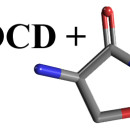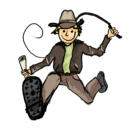Social Anxiety Treatment: CBT & Intentional Mistake Practice (an example)
When I was a kid, one form of mischief that was briefly popular in my neighborhood was crank calling strangers. Usually, the bravest kid in the group would pick up the phone, and with the encouragement of all the other kids in the room, would dial a random telephone number. A brief, very Bart Simpson-esque conversation would then ensue. Usually it would go something like this: Kid: Hello, ma’am. I am conducting a brief survey for the Grocer’s Association. Do you have a minute to answer a quick question? Stranger: Of course. How can I help you? Kid: I was wondering if you have Sara Lee in the freezer. Stranger: Why, yes I do. Kid: Well then let her out!!! We would then bust out in laughter and hang up the phone, leaving the recipient of our phone call...
Read MoreOCD & D-cycloserine: A Promising Medication for OCD Treatment
As someone who has long been enamored with basic science, I find it fascinating when classic medications are re-purposed in surprising ways. One of the newest examples of this is the use of D-cycloserine (also known as Seromycin) in the treatment of obsessive-compulsive disorder (OCD). What’s interesting about D-cycloserine is not so much what it is…but what it isn’t: D-cycloserine is neither an SRRI nor any other type of antidepressant (e.g., Prozac). It’s not an anti-anxiety medication (e.g., Xanax, Klonopin). It’s not even an atypical antipsychotic (e.g., Abilify, Risperdal). If it’s not one of the above, then what is it? The answer might surprise you. Seromycin is actually an antibiotic that was originally developed to help fight off tuberculosis. What’s exciting about using an antibiotic to treat OCD is that it’s not subject to the same side effects as other medications (i.e., the SSRIs,...
Read MoreTherapy as Science: You + Your Therapist + Scientific Method
I consider myself a scientist. I wear this hat officially when conducting research, but I also wear it every time I sit with a patient. In my research, my science is pretty self-evident: I identify a research question, develop falsifiable hypotheses, and then collect quantifiable data to see whether or not the phenomenon I’m studying behaves the way I think it does. A very similar process unfolds when I work with you in my clinic. However, from your vantage point, you might not realize it right away. Nevertheless, we are two collaborative empiricists. Most often, you will define the “research question”. Usually, this is the very reason that you’re coming to see me. Sometimes the questions we think we’re asking are not necessarily the ones we should be asking. For example, questions like, “Why is this happening to me?”...
Read MoreThe Power of Being Selfish: Selfishness as a Key to Mental Health
I’m about to tell you something that your mother might not approve of…so for those of you sensitive souls out there, you might want to click on something less controversial. Here it is: It’s okay (and sometimes even essential!) to be a little bit selfish. Conventional wisdom, and our parents, often tell us that it’s not okay to be selfish. If you want to be an effective parent, you must learn to put your kids’ needs before your own. Likewise, to be a good spouse, you must learn to honor your partner’s needs. These are truths, and if you aren’t living these truths in your daily life, it is likely that your relationships have suffered. However… As with anything, these truths must not be taken to extremes. I found myself thinking about this idea over the weekend as I...
Read MorePure-O OCD (Pure Obsessional OCD): Hidden Rituals
“Pure-O” OCD, or Pure Obsessional OCD, is a relatively less common form of OCD that seemingly differs from classic presentations of the illness. What distinguishes Pure Obsessional OCD from classic OCD is that in Pure-O OCD, symptoms are predominantly obsessive (rather than compulsive) in nature. Although individuals with Pure-O OCD frequently experience intense and distressing obsessions, they typically report few (if any) overt compulsive behaviors. However, in almost all cases, pure obsessionals do engage in a variety of rituals. These rituals just manifest as mental compulsions rather than behavioral compulsions. Unfortunately, most psychologists haven’t been trained in how to ask the types of questions that are necessary to identify these “hidden rituals.” As a consequence, these rituals often go undetected. Because effective treatment requires consistent response prevention, a failure to recognize and resist mental compulsions makes true exposure and response prevention (ERP) impossible. Treatment...
Read MoreExposure & Response Prevention (ERP) for OCD: Treatment Mechanism
How does ERP work? What mechanism underlies it? Obsessive-compulsive disorder (OCD) is characterized by obsessions and compulsions. Obsessions are disturbing thoughts, images, or impulses that increase feelings of anxiety. Compulsions (also known as “rituals”) are the strategies that individuals with OCD use to reduce the anxiety associated with obsessions. Rituals are effective coping strategies in the short-term, in that they lead to fairly rapid decreases in anxiety. However, rituals are considered maladaptive, because the anxiety relief they bring is short-lived. Engaging in rituals ultimately increases the likelihood that obsessions will be re-experienced in the future. This can be thought of as a positive feedback loop, in which compulsive behavior indirectly reinforces obsessions. This is depicted in the bottom half of the included figure. The treatment of choice for OCD is exposure and response prevention (ERP), which not surprisingly, has...
Read More








